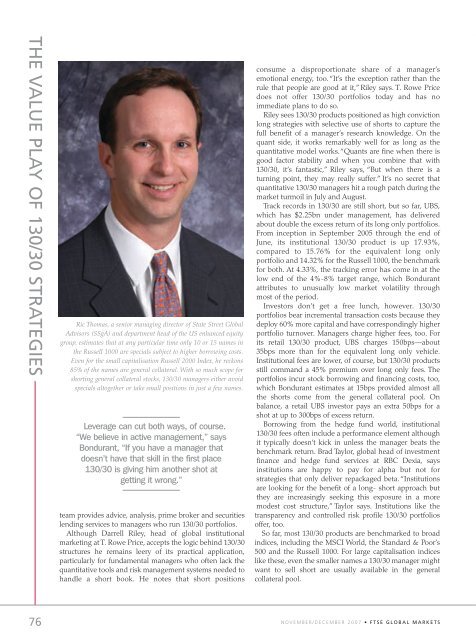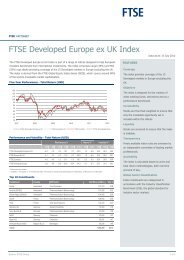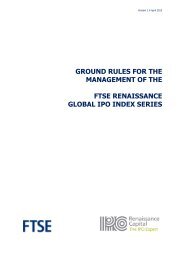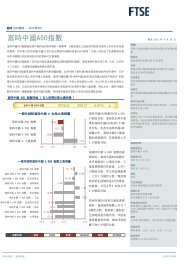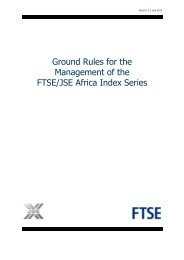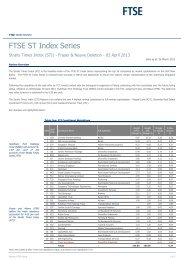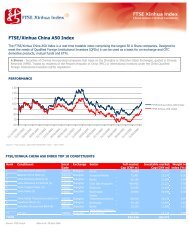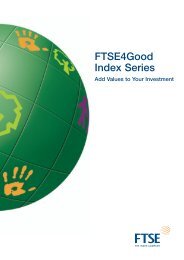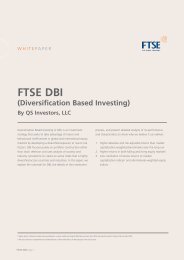Section 2 - FTSE
Section 2 - FTSE
Section 2 - FTSE
You also want an ePaper? Increase the reach of your titles
YUMPU automatically turns print PDFs into web optimized ePapers that Google loves.
THE VALUE PLAY OF 130/30 STRATEGIES<br />
76<br />
Ric Thomas, a senior managing director of State Street Global<br />
Advisors (SSgA) and department head of the US enhanced equity<br />
group, estimates that at any particular time only 10 or 15 names in<br />
the Russell 1000 are specials subject to higher borrowing costs.<br />
Even for the small capitalisation Russell 2000 Index, he reckons<br />
85% of the names are general collateral. With so much scope for<br />
shorting general collateral stocks, 130/30 managers either avoid<br />
specials altogether or take small positions in just a few names.<br />
Leverage can cut both ways, of course.<br />
“We believe in active management,” says<br />
Bondurant, “If you have a manager that<br />
doesn’t have that skill in the first place<br />
130/30 is giving him another shot at<br />
getting it wrong.”<br />
team provides advice, analysis, prime broker and securities<br />
lending services to managers who run 130/30 portfolios.<br />
Although Darrell Riley, head of global institutional<br />
marketing at T. Rowe Price, accepts the logic behind 130/30<br />
structures he remains leery of its practical application,<br />
particularly for fundamental managers who often lack the<br />
quantitative tools and risk management systems needed to<br />
handle a short book. He notes that short positions<br />
consume a disproportionate share of a manager’s<br />
emotional energy, too. “It’s the exception rather than the<br />
rule that people are good at it,” Riley says. T. Rowe Price<br />
does not offer 130/30 portfolios today and has no<br />
immediate plans to do so.<br />
Riley sees 130/30 products positioned as high conviction<br />
long strategies with selective use of shorts to capture the<br />
full benefit of a manager’s research knowledge. On the<br />
quant side, it works remarkably well for as long as the<br />
quantitative model works.“Quants are fine when there is<br />
good factor stability and when you combine that with<br />
130/30, it’s fantastic,” Riley says, “But when there is a<br />
turning point, they may really suffer.” It’s no secret that<br />
quantitative 130/30 managers hit a rough patch during the<br />
market turmoil in July and August.<br />
Track records in 130/30 are still short, but so far, UBS,<br />
which has $2.25bn under management, has delivered<br />
about double the excess return of its long only portfolios.<br />
From inception in September 2005 through the end of<br />
June, its institutional 130/30 product is up 17.93%,<br />
compared to 15.76% for the equivalent long only<br />
portfolio and 14.32% for the Russell 1000, the benchmark<br />
for both. At 4.33%, the tracking error has come in at the<br />
low end of the 4%-8% target range, which Bondurant<br />
attributes to unusually low market volatility through<br />
most of the period.<br />
Investors don’t get a free lunch, however. 130/30<br />
portfolios bear incremental transaction costs because they<br />
deploy 60% more capital and have correspondingly higher<br />
portfolio turnover. Managers charge higher fees, too. For<br />
its retail 130/30 product, UBS charges 150bps—about<br />
35bps more than for the equivalent long only vehicle.<br />
Institutional fees are lower, of course, but 130/30 products<br />
still command a 45% premium over long only fees. The<br />
portfolios incur stock borrowing and financing costs, too,<br />
which Bondurant estimates at 15bps provided almost all<br />
the shorts come from the general collateral pool. On<br />
balance, a retail UBS investor pays an extra 50bps for a<br />
shot at up to 300bps of excess return.<br />
Borrowing from the hedge fund world, institutional<br />
130/30 fees often include a performance element although<br />
it typically doesn’t kick in unless the manager beats the<br />
benchmark return. Brad Taylor, global head of investment<br />
finance and hedge fund services at RBC Dexia, says<br />
institutions are happy to pay for alpha but not for<br />
strategies that only deliver repackaged beta. “Institutions<br />
are looking for the benefit of a long- short approach but<br />
they are increasingly seeking this exposure in a more<br />
modest cost structure,” Taylor says. Institutions like the<br />
transparency and controlled risk profile 130/30 portfolios<br />
offer, too.<br />
So far, most 130/30 products are benchmarked to broad<br />
indices, including the MSCI World, the Standard & Poor’s<br />
500 and the Russell 1000. For large capitalisation indices<br />
like these, even the smaller names a 130/30 manager might<br />
want to sell short are usually available in the general<br />
collateral pool.<br />
NOVEMBER/DECEMBER 2007 • <strong>FTSE</strong> GLOBAL MARKETS


